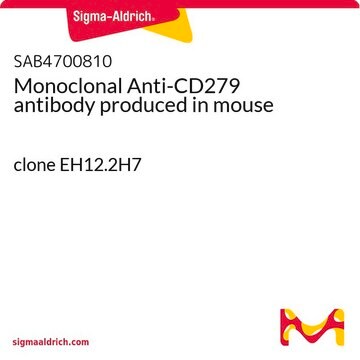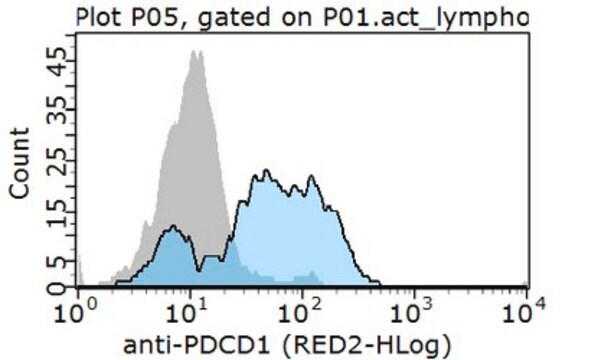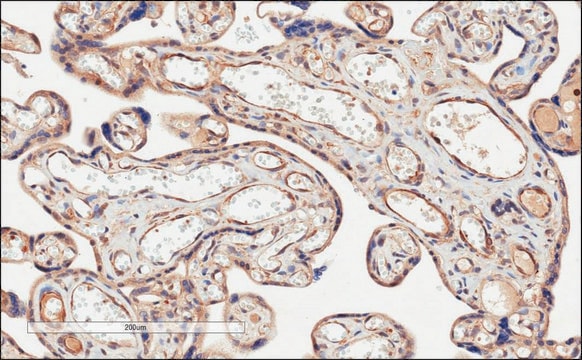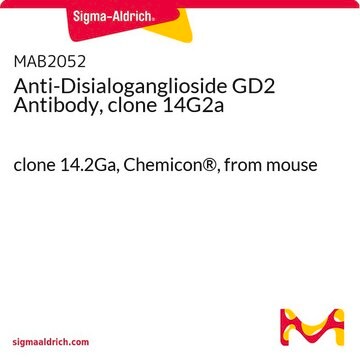MABC980
Anti-PD-L1 Antibody, clone 29E.2A3.C6, Azide Free
clone 29E.2A3.C6, from mouse
Sinonimo/i:
Programmed cell death 1 ligand 1, B7-H1, B7 homolog 1, CD274, PD-L1, PDCD1 ligand 1, Programmed death ligand 1
About This Item
Prodotti consigliati
Origine biologica
mouse
Livello qualitativo
Forma dell’anticorpo
purified immunoglobulin
Tipo di anticorpo
primary antibodies
Clone
29E.2A3.C6, monoclonal
Reattività contro le specie
rat, chimpanzee, human
tecniche
flow cytometry: suitable
immunocytochemistry: suitable
immunohistochemistry: suitable (paraffin)
neutralization: suitable
Isotipo
IgG2bκ
N° accesso NCBI
N° accesso UniProt
Condizioni di spedizione
dry ice
modifica post-traduzionali bersaglio
unmodified
Informazioni sul gene
human ... CD274(29126)
Descrizione generale
Specificità
Immunogeno
Applicazioni
Flow Cytometry Analysis: 0.1 µg of this antibody from a representative lot detected PD-L1 in MDA-MB-231 cells.
Flow Cytometry Analysis: A representative lot immunostained the surface of 300.19 murine pre-B lymphoma cells transfected with human PD-L1, but not the untransfected cells or cells transfected with human PD-L2 (Brown, J.A., et al. (2003). J. Immunol. 170(3):1257-1266).
Flow Cytometry Analysis: A representative lot detected surface PD-L1 expression on human breast cancer cell lines MDA-231, SKBR-3, and MCF-7, but not BT-474 (Latchman, Y., et al. (2001). J. Nat. Immunol.2(3):261-268).
Immunohistochemistry Analysis: A representative lot detected PD-L1 expression pattern in frozen fetal (thymus & cardiac tissue) and paraffin-embedded adult (tonsillar germinal center and placenta) human tissue sections (Brown, J.A., et al. (2003). J. Immunol. 170(3):1257-1266).
Immunohistochemistry Analysis: A representative lot detected PD-L1 expression in paraffin-embedded human cancer tissue sections, including anaplastic large cell lymphoma, squamous cell carcinoma of the tongue, colon adenocarcinoma, and invasive breast ductal carcinoma (Brown, J.A., et al. (2003). J. Immunol. 170(3):1257-1266).
Neutralizing Analysis: A representative lot competed against human PD-1 extracellular domain Ig fusion for the binding of exogenously expressed human PD-L1 on the surface of 300.19 murine pre-B lymphoma cells (Brown, J.A., et al. (2003). J. Immunol. 170(3):1257-1266).
Neutralizing Analysis: A representative lot enhanced cytokines production from CD4 T-cells upon HIV Gag peptides stimulation of CD8+-depleted human PBMCs (Porichis, F., et al. (2011). Blood. 118(4):965-974).
Neutralizing Analysis: A representative lot restored HCV peptides-induced expansion of CD8+ T cells in cultured intrahepatic lymphocytes from a chimpanzee with 10 years of chronic HCV infection (Fuller, M.J., et al. (2013). Proc. Natl. Acad. Sci. U. S. A. 110(37):15001-15006).
Neutralizing Analysis: Dual blockage of both DP-L1 clone 29E.2A3.C6 Fab fragment and DP-L2 by clone 24F.10C12 (Cat. No. MABC969) Fab fragment on PBMC-derived dendric cells (DCs) boosted the enhancing effect on CD4+ T-cell proliferation and cytokine release seen with DP-L2 blockage alone in allogenic cultures with immature DCs (iDC), mature DCs (mDC), and IL-10-treated mDCs (Brown, J.A., et al. (2003). J. Immunol. 170(3):1257-1266).
Immunocytochemistry Analysis: A representative lot detected an upregulated PD-L1 immunoreactivity in human CD14+ monocyte-derived macrophages (MDMs) following HIV infection or TLR4/8 stimulation (by LPS or CL097 treatment) by fluorescent immunocytochemistry using paraformaldehyde-fixed MDMs (Rodríguez-García, M., et al. (2011). J. Leukoc. Biol. 89(4) 507–515).
Apoptosis & Cancer
Apoptosis - Additional
Qualità
Immunohistochemistry Analysis: An 1:50 dilution of this antibody detected PD-L1 in human cerebral cortex tissue.
Descrizione del bersaglio
Stato fisico
Stoccaggio e stabilità
Handling Recommendations: Upon receipt and prior to removing the cap, centrifuge the vial and gently mix the solution. Aliquot into microcentrifuge tubes and store at -20°C. Avoid repeated freeze/thaw cycles, which may damage IgG and affect product performance.
Altre note
Esclusione di responsabilità
Not finding the right product?
Try our Motore di ricerca dei prodotti.
Raccomandato
Codice della classe di stoccaggio
12 - Non Combustible Liquids
Classe di pericolosità dell'acqua (WGK)
WGK 2
Punto d’infiammabilità (°F)
Not applicable
Punto d’infiammabilità (°C)
Not applicable
Certificati d'analisi (COA)
Cerca il Certificati d'analisi (COA) digitando il numero di lotto/batch corrispondente. I numeri di lotto o di batch sono stampati sull'etichetta dei prodotti dopo la parola ‘Lotto’ o ‘Batch’.
Possiedi già questo prodotto?
I documenti relativi ai prodotti acquistati recentemente sono disponibili nell’Archivio dei documenti.
I clienti hanno visto anche
Il team dei nostri ricercatori vanta grande esperienza in tutte le aree della ricerca quali Life Science, scienza dei materiali, sintesi chimica, cromatografia, discipline analitiche, ecc..
Contatta l'Assistenza Tecnica.












